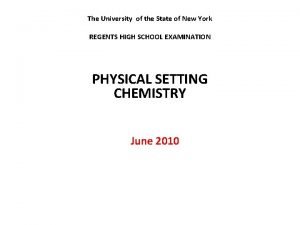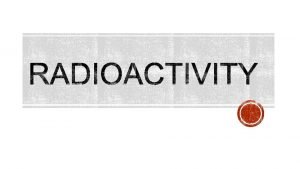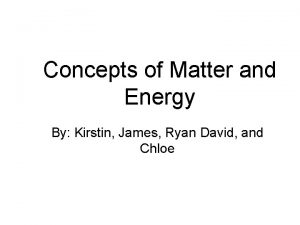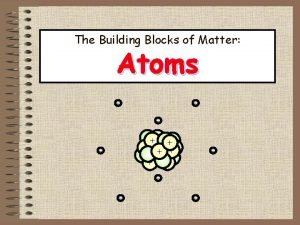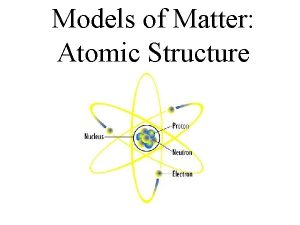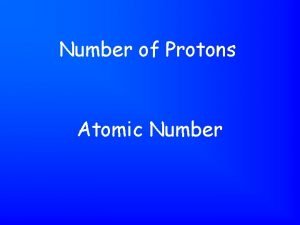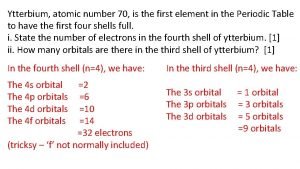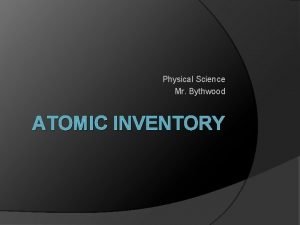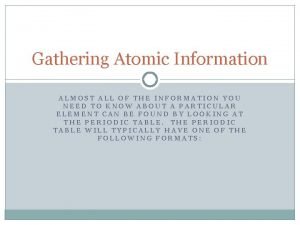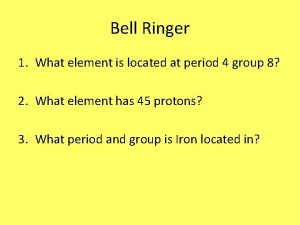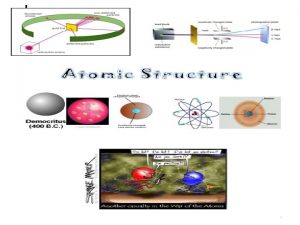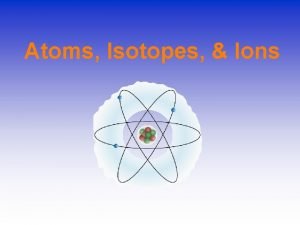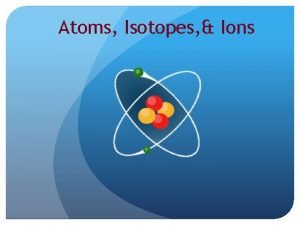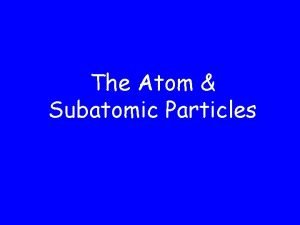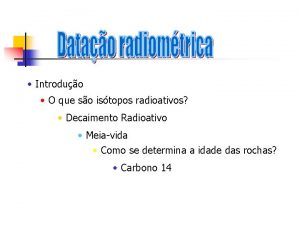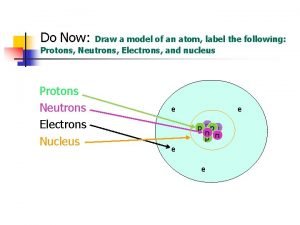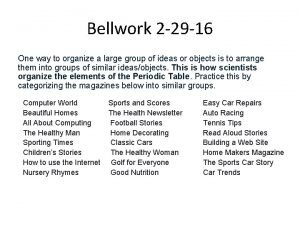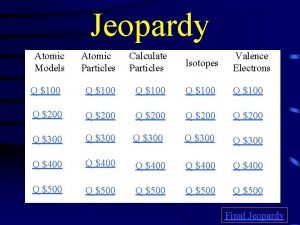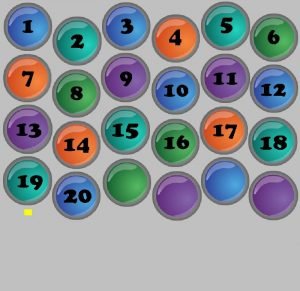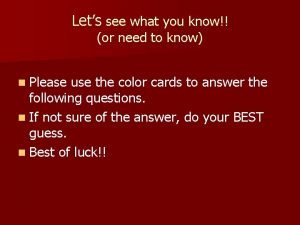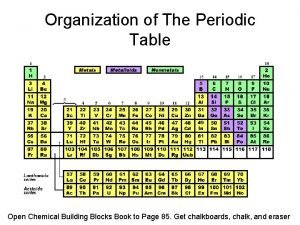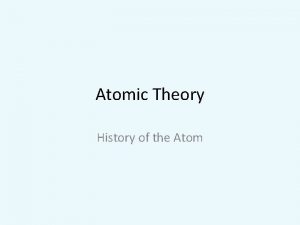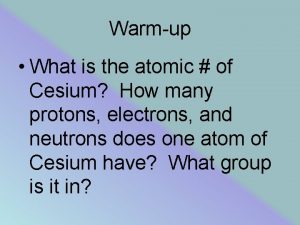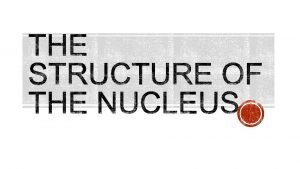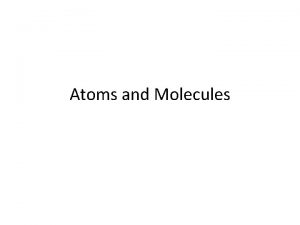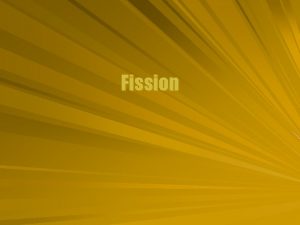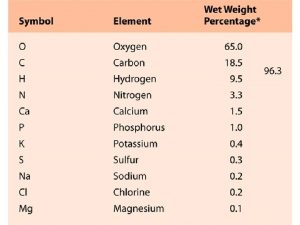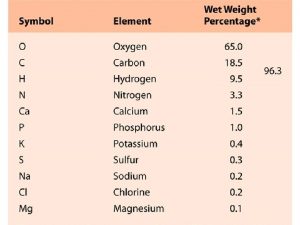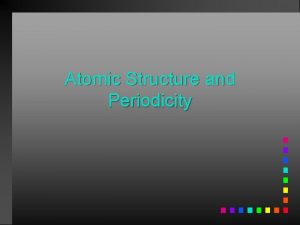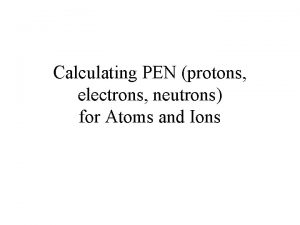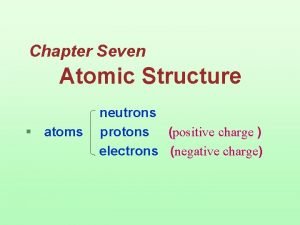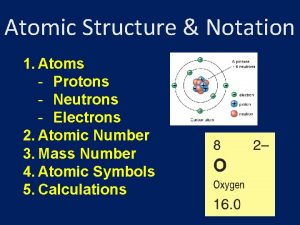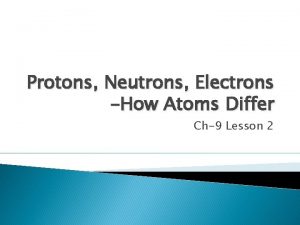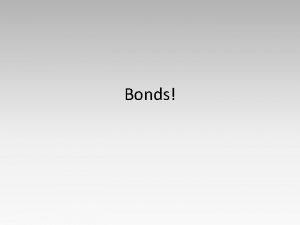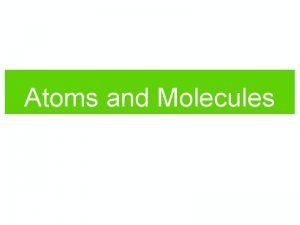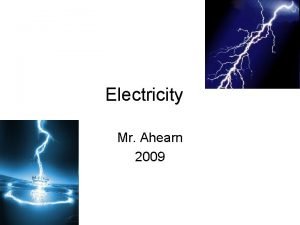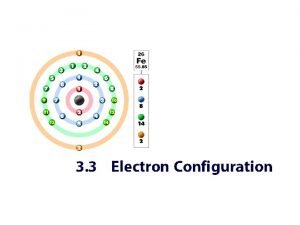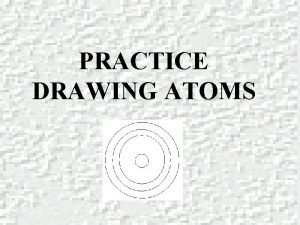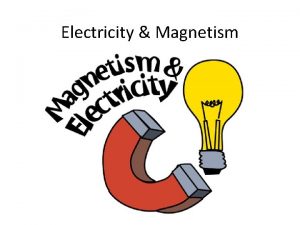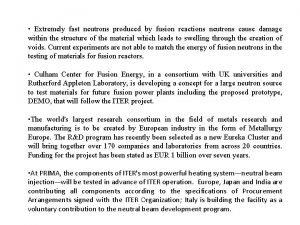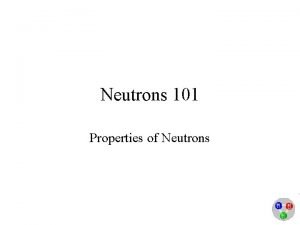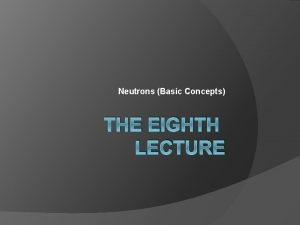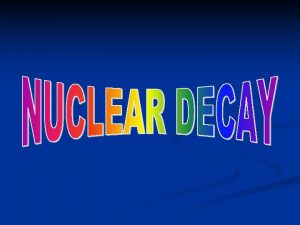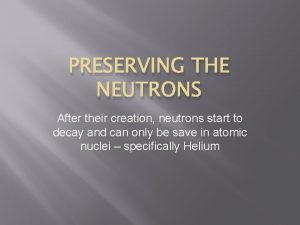TOPIC 9 ELECTRICITY Atoms Have neutrons protons and
































- Slides: 32

TOPIC 9 ELECTRICITY

Atoms • Have neutrons, protons, and electrons. • Protons are positively charged • Electrons are negatively charged

Electrons • Are located on the outer edges of atoms…they can be moved. • A concentration of electrons in an atom creates a net negative charge. • If electrons are stripped away, the atom becomes positively charged

The world is filled with electrical charges - - -

What is this electrical potential called? • Static Electricity

Static Electricity • The build up of an electric charge on the surface of an object. • The charge builds up but does not flow. • Static electricity is potential energy • It does not move • It is stored

Conservation of Charge • Conservation of Charge: Electrical charge can be transferred from one object to another but it cannot be created or destroyed • Sound Familiar?

When two objects rub against each other electrons transfer and build up on an object causing it to have a different charge from its surroundings. Like the shoes rubbing against the carpet. Electrons are transferred from the carpet to the shoes.


Static Discharge or Transfer of Charge • Occurs when there is a loss of static electricity due to three possible things: • Friction - rubbing • Conduction – direct contact • Induction – through an electrical field (not direct contact)

Conductors • Conductors are materials that allow electrons to move freely • We did a conduction lab • What material was a good conductor?

Insulators • Insulators are materials that don’t allow electrons to move freely • Energy takes a lot longer to transfer • Think of the conduction lab again, which of the materials was the insulator? • The plastic coating around metal wires prevents electrical charge when you touch it

Charging Objects • Charges can transfer from one object to the next just by touching • This is called charging by contact • Better known as friction • Charging by induction is the use of an electrical field instead of an object to transfer charge

• John Travoltage - Voltage, Static Electricity, Electricity – Ph. ET • NOVA (PBS) - Lightning! (1995) – You. Tube • Lightning Strikes! - You. Tube

Electricity that moves… l Current: The flow of electrons from one place to another. l Measured in amperes (amps) l Kinetic energy

There are 2 types of currents: l Direct Current (DC) – Where electrons flow in the same direction in a wire.

There are 2 types of currents: l Alternating Current (AC) – electrons flow in different directions in a wire

How can we control currents? l With circuits l Circuit: is a path for the flow of electrons l We use wires

There are 2 types of circuits: l Series Circuit: the components are lined up along one path. If the circuit is broken, all components turn off.

Series Circuit

There are 2 types of circuits: l Parallel Circuit – there are several branching paths to the components. l If the circuit is broken at any one branch, only the components on that branch will turn off.

Parallel Circuit

What is Resistance? l The opposition to the flow of an electric current, producing heat. l The greater the resistance, the less current gets through. l Good conductors have low resistance. l Measured in ohms.

What is Voltage? l The measure of energy given to the charge flowing in a circuit. l The greater the voltage, the greater the force or “pressure” that drives the charge through the circuit.

Difference b/t Volts and Amps l Example l Amps – you could say that… measure how much water comes out of a hose. l Volts measure how hard the water comes out of a hose.

Ohm’s Law l Resistance l Ohms = Voltage / Current = Volts / Amps

Ohms Triangle

Practice with Ohm’s Law Ohms 4 15 2 9 6 Volts 100 150 30 45 48 Amps 25 10 15 5 8

What is an electromagnet? l Electromagnet – a magnet made from a current bearing coil of wire wrapped around an iron or steel core.

What is a generator? l Generator – a machine that changes mechanical energy to electrical energy l Usually use moving magnets to create currents in coils of wire.

What is a motor? l Motor – a device that changes electrical energy to mechanical energy that can do work.

What is a battery A battery provides the needed voltage to keep a current flowing in a circuit l There are two types of batteries: l l Dry Cell: most common (AAA, AA) two electrodes surrounded by material called electrolytes l Wet Cell: (Car battery), Plates of metal of different compounds in a conducting solutions a wet cell battery is many of these cells put together
 Can an atom have more neutrons than protons
Can an atom have more neutrons than protons Can an atom have more neutrons than protons
Can an atom have more neutrons than protons Can an atom have more neutrons than protons
Can an atom have more neutrons than protons Protons and neutrons size
Protons and neutrons size Number of neutron of gold
Number of neutron of gold Lithium number of protons and neutrons
Lithium number of protons and neutrons Sulfur number of neutrons protons and electrons
Sulfur number of neutrons protons and electrons Carbon family fifth period
Carbon family fifth period 23na11 and 24mg12 are
23na11 and 24mg12 are Ytterbium number of protons
Ytterbium number of protons Subatomic particles chart
Subatomic particles chart What is an atom inventory
What is an atom inventory Which number is protons on periodic table
Which number is protons on periodic table Lithium protons neutrons electrons
Lithium protons neutrons electrons How many protons does chromium-58 have
How many protons does chromium-58 have Bc atomic mass
Bc atomic mass 39k+ protons neutrons electrons
39k+ protons neutrons electrons 39k+ protons neutrons electrons
39k+ protons neutrons electrons Describe neutrons.location: charge: mass:
Describe neutrons.location: charge: mass: Qumica
Qumica Chlorine protons neutrons electrons
Chlorine protons neutrons electrons Static electricity and current electricity
Static electricity and current electricity Static electricity and current electricity
Static electricity and current electricity How are static electricity and current electricity alike
How are static electricity and current electricity alike At stp which substance is the best conductor of electricity
At stp which substance is the best conductor of electricity Does mercury have more protons and electrons than tin
Does mercury have more protons and electrons than tin How many neutrons does francium have
How many neutrons does francium have An industrially important element contains 26
An industrially important element contains 26 How many neutrons does the isotope n-14 have
How many neutrons does the isotope n-14 have What element am i
What element am i Atomic model history
Atomic model history How many protons does cesium have
How many protons does cesium have Example of a clincher
Example of a clincher
